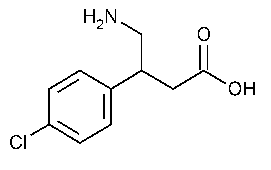Baclofen
Butanoic acid,4-amino-3-(4-chlorophenyl)-.
b-(Aminomethyl)-p-chlorohydrocinnamic acid [1134-47-0].
»Baclofen contains not less than 99.0percent and not more than 101.0percent of C10H12ClNO2,calculated on the anhydrous basis.
Packaging and storage—
Preserve in tight containers.
Identification,Infrared Absorption á197Mñ.
Water,Method Iá921ñ:
not more than 3.0%.
Residue on ignition á281ñ:
not more than 0.3%.
Heavy metals,Method IIá231ñ:
0.001%.
Related compounds—
[Caution—Avoid contact with o-tolidine when performing this test,and conduct the test in a well-ventilated hood.]
Detection reagent—
Dissolve 200mg of o-tolidine in 2.0mLof glacial acetic acid with the aid of a hot water bath.Dilute with water to 100.0mL,and filter.Mix one volume of this solution with an equal volume of potassium iodide solution (0.83in 100).
Diluting solution—
Prepare a mixture of alcohol and glacial acetic acid (4:1).
Standard preparations—
Dissolve USP Baclofen RSin Diluting solutionto obtain a Standard stock solutionhaving a known concentration of 0.1mg per mL.Dilute portions of this Standard stock solutionquantitatively with Diluting solutionto obtain solutions having concentrations of 0.05mg per mL(Standard preparation A)and 0.03mg per mL(Standard preparation B),respectively.
Identification preparation—
Dissolve USP Baclofen Related Compound A RSin Diluting solutionto obtain a solution having a known concentration of 0.1mg per mL.
Test preparation—
Prepare a solution in Diluting solutioncontaining 10.0mg of Baclofen per mL.
Procedure—
Apply separately 10µLof the Test preparation,Identification preparation,Standard preparation A,and Standard preparation Bto a suitable thin-layer chromatographic plate (see Chromatography á621ñ,coated with a 0.25-mm layer of chromatographic silica gel mixture.Place the plate in a chromatographic chamber,and develop the chromatograms in a solvent system consisting of a mixture of butyl alcohol,glacial acetic acid,and water (4:1:1)until the solvent front has moved about three-fourths of the length of the plate.Remove the plate from the developing chamber,and dry under a current of warm air.Transfer the dry plate to another chromatographic chamber containing a beaker with 1g of potassium permanganate.Add 10mLof dilute hydrochloric acid (4in 10)to the beaker.Cover the chamber,and allow the chamber to become saturated with chlorine gas.Expose the plate to the chlorine gas for 8minutes.Remove the plate and expose to the air for 2minutes,then spray with freshly prepared Detection reagent:the intensity of the secondary spot from the Test preparation,corresponding in RFvalue to the principal spot from the Identification preparation,is not greater than that of the principal spot from the Identification preparation(1.0%),and no other secondary spot from the Test preparationis greater in intensity than the principal spot from Standard preparation A(0.5%).The sum of all secondary spots from the Test preparationis not more than 2.0%.
Organic volatile impurities,Method IVá467ñ:
meets the requirements.
Assay—
Dissolve about 40mg of Baclofen,accurately weighed,in 10mLof glacial acetic acid TS,and titrate with 0.1Nperchloric acid VS,determining the endpoint potentiometrically,using a glass electrode and a calomel electrode containing a saturated solution of lithium chloride in glacial acetic acid (see Titrimetry á541ñ).Perform a blank determination,and make any necessary correction.Each mLof 0.1Nperchloric acid is equivalent to 21.37mg of C10H12ClNO2.
Auxiliary Information—
Staff Liaison:Ravi Ravichandran,Ph.D.,Senior Scientist
Expert Committee:(PA3)Pharmaceutical Analysis 3
USP28–NF23Page 217
Pharmacopeial Forum:Volume No.29(6)Page 1848
Phone Number:1-301-816-8330
